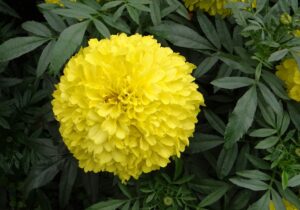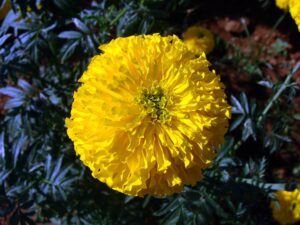African Marigold, scientifically known as Tagetes erecta, is a beloved and iconic annual flowering plant renowned for its resplendent, fully double blooms, and striking presence in gardens across the globe. Hailing from its native lands of Mexico and Central America, this botanical gem has captured the hearts of gardeners with its vibrant and alluring characteristics.
The hallmark of African Marigold lies in its magnificent flowers, which can reach an impressive diameter of 4 to 5 inches (10-12 cm). These blossoms are a visual symphony of warm and vivid colors, including various shades of radiant yellow, rich orange, and gleaming gold. Some cultivars even sport hints of red and maroon, adding diversity to their palette.
African Marigolds boast a statuesque and upright growth habit, reaching heights of 1 to 3 feet (30 to 90 cm), thereby providing vertical interest in gardens.
The dark green leaves of African Marigolds are finely divided and have a feathery appearance. They are pinnately compound, meaning they have multiple leaflets arranged along a central stem.
The most striking feature of African Marigold is its large, fully double flowers. These flowers can be as wide as 4 to 5 inches (10-12 cm) in diameter, and they have a globe-like shape with numerous layers of petals. African Marigold flowers come in a range of warm and vivid colors, including various shades of yellow, orange, and gold. Some cultivars may also exhibit red or maroon hues. The vibrant, eye-catching blossoms make African Marigolds a popular choice for ornamental gardening.

African Marigolds are known for their distinctive, somewhat pungent scent, which can help deter certain garden pests when used as companion plants.
Due to their striking appearance and ease of care, African Marigolds are a popular choice for gardeners looking to add a splash of vibrant color to their gardens. They can be grown from seeds and are often found in garden centers as bedding plants.
Cultivars of African Marigold
African Marigolds (Tagetes erecta) are available in various cultivars, each offering unique features in terms of flower color, size, and growth habits. Here are some popular cultivars of African Marigold:
‘Inca II’: This cultivar produces large, fully double blooms in shades of yellow and orange. It’s known for its impressive flower size and vibrant colors.
‘Crackerjack Mix’: A mix of tall African Marigolds with large, full, and varied-colored flowers. This cultivar offers a stunning array of colors, making it a favorite among gardeners.
‘Antigua’: ‘Antigua’ is a compact African Marigold variety with fully double flowers. It comes in various colors and is well-suited for bedding and container planting.
‘Safari Series’: The ‘Safari’ series includes various cultivars bred for disease resistance and uniform growth. They come in an assortment of colors and are prized for their reliability and performance.
‘Discovery Series’: These are unique hybrid African Marigolds that combine characteristics of both African and French Marigolds. They offer a mix of colors and have a balanced growth habit.
‘Hero Series’: Compact and early-blooming, the ‘Hero’ series features African Marigolds in various flower colors. They are known for their strong and sturdy growth.
‘Zenith Series’: These African Marigolds are dwarf in stature and produce large, double flowers in various shades. They are ideal for bedding and borders.
‘Harlequin Series’: This series is known for its striking bicolor blooms, which add a touch of uniqueness to your garden with flowers displaying two distinct colors.
‘Taishan Series’: These compact, early-blooming African Marigolds are available in a range of flower colors and are perfect for edging or mass planting.
‘Giant Yellow’: As the name suggests, this cultivar produces extra-large, bright yellow blooms, making it a standout feature in gardens.

When selecting an African Marigold cultivar for your garden, consider factors such as the expected height of the plant, flower color preferences, and the overall design of your garden. Whether you’re looking for a compact variety for borders, a taller selection for focal points, or a mix of colors for a vibrant display, there is likely an African Marigold cultivar that suits your gardening needs.
Sunlight Requirements of African Marigold
African Marigolds (Tagetes erecta) thrive in full sunlight. They have a high sunlight requirement and do best when grown in an area that receives at least 6 to 8 hours of direct sunlight each day.
They require exposure to full sunlight to develop their strong stems, lush foliage, and vibrant, fully double flowers. Inadequate sunlight can lead to leggy, weak growth, and reduced flower production.
African Marigolds have limited tolerance for shade. Planting them in areas with insufficient sunlight will result in reduced flowering and less vigorous growth.
When growing African Marigolds in containers, ensure that the containers are placed in a location that receives adequate sunlight throughout the day. Position them on patios, balconies, or windowsills where they can access full sun.
Soil Required to Grow African Marigold
African Marigolds (Tagetes erecta) are relatively adaptable when it comes to soil, but they do best in well-drained, fertile soil. The ideal soil pH for African Marigolds is slightly acidic to neutral, with a range of 6.0 to 7.0. Most garden soils fall within this pH range, making it suitable for marigold growth. African Marigolds can adapt to various soil types, including loamy, sandy, or clayey soils. However, loamy soils with good drainage are often considered the best for their growth. African Marigolds prefer soil that drains well to prevent waterlogged conditions, which can lead to root rot. Ensure that the soil doesn’t retain excessive moisture.

Propagation through seed sowing
Direct Sowing: The most common method of propagating African Marigolds is by sowing seeds directly into the garden soil after the danger of frost has passed. Prepare a well-drained garden bed, sprinkle the seeds on the surface, lightly press them into the soil, and keep the soil consistently moist until seedlings emerge.
Propagating African Marigolds (Tagetes erecta) through seed sowing is a straightforward and cost-effective method. Here’s a step-by-step guide on how to propagate African Marigolds from seeds:
The ideal time to sow African Marigold seeds is indoors 2-3 weeks before the last expected frost date in your region. This allows the seedlings to become well-established before transplanting them into the garden.
Fill seed trays or small pots with a high-quality seed starting mix or a well-draining potting soil. Make sure the containers have drainage holes.
Sow the African Marigold seeds on the surface of the soil. Space them about 2-3 inches apart to allow room for growth.
Gently press the seeds into the soil but do not bury them deeply, as marigold seeds require light for germination.
Water the soil lightly to ensure good seed-to-soil contact. A fine mist from a watering can or spray bottle works well. The soil should be evenly moist but not waterlogged.
Cover the seed trays or pots with transparent plastic wrap or a propagation dome to create a mini greenhouse effect. This helps maintain a humid environment for germination.
Place the seed trays or pots in a warm and well-lit location. You can use grow lights or a bright, sunny windowsill. African Marigold seeds germinate best at temperatures between 70-75°F (21-24°C).
Check the seed trays or pots regularly to ensure that the soil remains consistently moist but not waterlogged. Mist the soil with water as needed.
African Marigold seeds typically germinate within 5-7 days, although it may take a little longer in some cases.
Once the seedlings have developed a couple of true leaves and the risk of frost has passed, it’s time to transplant them into the garden. Transplant them to a sunny spot with well-drained soil, spacing them according to the plant’s mature size, which is typically around 8-12 inches apart.
Water requirements
African Marigolds prefer consistent moisture but do not tolerate waterlogged or overly wet soil. The goal is to keep the soil evenly moist but not soggy.
Once African Marigold plants are established and have developed a healthy root system they become somewhat drought-tolerant. During this phase, you can allow the top inch or so of soil to dry out between watering.
Water the soil around the base of the plants, not overhead. This helps prevent fungal diseases and keeps the foliage dry. Drip irrigation or a soaker hose is ideal for precise watering.
Be cautious not to overwater, as overly wet soil can lead to root rot. Check the soil moisture with your finger or a moisture meter before watering. If the top inch of soil feels dry to the touch, it’s time to water.
Take into account natural rainfall when determining how often to water your marigolds. Adjust your watering schedule accordingly. During rainy periods, you may need to water less.
Container Planting: If you’re growing African Marigolds in containers, check the moisture level more frequently, as containers tend to dry out faster than garden soil. Water thoroughly when the top inch of the potting mix feels dry.
Fertilizer requirements
African Marigolds (Tagetes erecta), have specific fertilizer requirements to support their growth and blooming.
Balanced Fertilizer: Use a balanced, all-purpose fertilizer with an equal ratio of nitrogen (N), phosphorus (P), and potassium (K), such as a 10-10-10 or 20-20-20 formula. This ensures that the plant receives the essential nutrients in proper proportions.
Before planting marigolds, amend the soil with well-rotted compost or organic matter. This helps improve soil fertility and provides a slow-release source of nutrients.
Early Growth Stage: After the marigold seedlings have been transplanted into the garden and have developed a few sets of true leaves, you can apply a light application of balanced fertilizer. This can be done around 3-4 weeks after planting.
Throughout the Growing Season: Continue to fertilize marigolds throughout the growing season. A light application of a balanced, water-soluble fertilizer can be applied every 4-6 weeks. Alternatively, use slow-release granular fertilizers that provide nutrients gradually over time.
While marigolds benefit from nitrogen for lush foliage, excessive nitrogen can lead to vigorous leafy growth at the expense of flowering. Therefore, avoid high-nitrogen fertilizers.
When growing marigolds in containers, use a slow-release, balanced fertilizer specifically formulated for container gardening. Follow the product’s instructions for application.
Deadheading African Marigold flowers
Deadheading is a common gardening practice used to encourage more blooms and maintain the overall appearance of plants. Deadheading African Marigold (Tagetes erecta) flowers can help keep the plants looking fresh and vibrant.
African Marigolds benefit from regular deadheading to encourage continuous flowering. Check your plants every few days or at least once a week during the growing season.
Examine your African Marigold plants for spent or fading flowers. Spent flowers are those that have withered, lost their color, and are starting to produce seeds.
Using your fingers or clean gardening shears or scissors, pinch or cut the stem just above the set of healthy leaves or flower buds. This removes the spent flower along with the stem.
Removing spent flowers prompts the plant to produce new flower buds. This results in a prolonged and continuous display of colorful blooms throughout the growing season.
Problems While Growing African Marigold
Marigolds are generally easy to grow, but like any plant, they can face certain problems and challenges. Here are some common issues you might encounter while growing marigold flowers and how to address them:
Pests:
Aphids and Whiteflies: These small insects can damage marigold plants by sucking sap from the leaves. Use insecticidal soap or neem oil to control them.
Spider Mites: These tiny arachnids can cause stippling and webbing on marigold leaves. Keep the plants well-hydrated and use a strong spray of water to dislodge the mites.
Nematodes: These microscopic worms can damage the roots of marigold plants. Use nematode-resistant marigold varieties or practice crop rotation to reduce nematode populations.
Disease:
Powdery Mildew: This fungal disease can affect marigold leaves. Improve air circulation, avoid overhead watering, and use a fungicide as a preventive measure.
Root Rot: Caused by overly wet or poorly draining soil, root rot can be prevented by ensuring proper drainage and avoiding overwatering.
Botrytis Blight: Gray mold can occur in wet and cool conditions. Remove affected plant material, and ensure good air circulation.
Overwatering or Poor Drainage:
Marigolds prefer well-draining soil. Overwatering or planting in soggy conditions can lead to root rot. Water the plants deeply when the top inch of soil is dry, but don’t let them sit in standing water.
Inadequate Sunlight:
Marigolds require full sun, which means at least 6-8 hours of direct sunlight per day. Lack of sun can result in leggy growth and reduced flowering.
Fertilization Issues:
Over-fertilization can lead to excessive foliage growth and reduced flowering. Follow recommended fertilization guidelines and avoid using high-nitrogen fertilizers.
Under-fertilization can result in pale or stunted growth. Use a balanced, water-soluble fertilizer according to package instructions.
By addressing these common problems and providing proper care, you can enjoy healthy and vibrant marigold flowers in your garden. Regular monitoring and timely action can help prevent and resolve most of these issues.
Uses of African Marigold
African Marigolds (Tagetes erecta) are commonly used for ornamental purposes in gardens and landscapes due to their striking and vibrant flowers. Here are some specific ornamental uses of African Marigolds:
Flower Beds and Borders: African Marigolds are often planted in flower beds and along garden borders to add a splash of color and visual interest. Their bold, fully double blooms in shades of yellow, orange, and gold create eye-catching displays.

Mass Plantings: These marigolds are frequently used for mass plantings to create stunning, cohesive, and uniform displays of color. Their upright growth habit makes them ideal for this purpose.
Container Gardening: African Marigolds are well-suited for container gardening. They can be grown in pots, hanging baskets, and window boxes to provide bright and compact floral arrangements on patios, balconies, and porches.
Cut Flower Arrangements: Gardeners and florists alike use African Marigold flowers in cut flower arrangements. The long-lasting, large, and colorful blooms make them an excellent choice for creating fresh bouquets and floral centerpieces.

Companion Plants: In vegetable and herb gardens, African Marigolds are often planted alongside other crops as companion plants. Their pungent scent can help deter pests like aphids and nematodes, thus protecting the nearby plants from infestations.

Mixed Plantings: African Marigolds can be combined with other annual and perennial flowers to create mixed plantings with diverse colors and textures. They work well in combination with plants like zinnias, petunias, and salvia.
Landscape Focal Points: These marigolds can be used as focal points within a garden or landscape due to their large and showy flowers. Placing them strategically can draw attention and create a focal area of interest.
Seasonal Displays: African Marigolds are often used in seasonal displays, such as fall and Halloween decorations. Their warm, autumnal colors make them a favorite choice for seasonal plantings and floral decorations.
Public Gardens and Parks: Public gardens and parks often feature African Marigolds in their displays due to their stunning appearance and low maintenance requirements.
Cut Flowers: The large, long-lasting blooms of African Marigolds are commonly used in cut flower arrangements and floral bouquets. Their bright colors and striking appearance make them a favorite choice for creating beautiful indoor floral displays.
Edible Uses: In some cultures, African Marigolds are used in culinary applications. The petals of the flowers are sometimes added to salads, soups, and as a garnish. However, they should be used sparingly, as their flavor can be quite strong, with hints of citrus and spice.
Insect Repellent: African Marigolds are sometimes used to deter insects when planted near outdoor seating areas or entryways. Their scent can help keep certain pests at bay.

Whether used as stand-alone specimens, mass plantings, or in combination with other flowers, African Marigolds are cherished for their ability to add vibrancy, color, and a touch of elegance to various ornamental gardening settings. Their easy care and wide range of cultivars and colors make them a versatile choice for creating beautiful and visually appealing landscapes.


